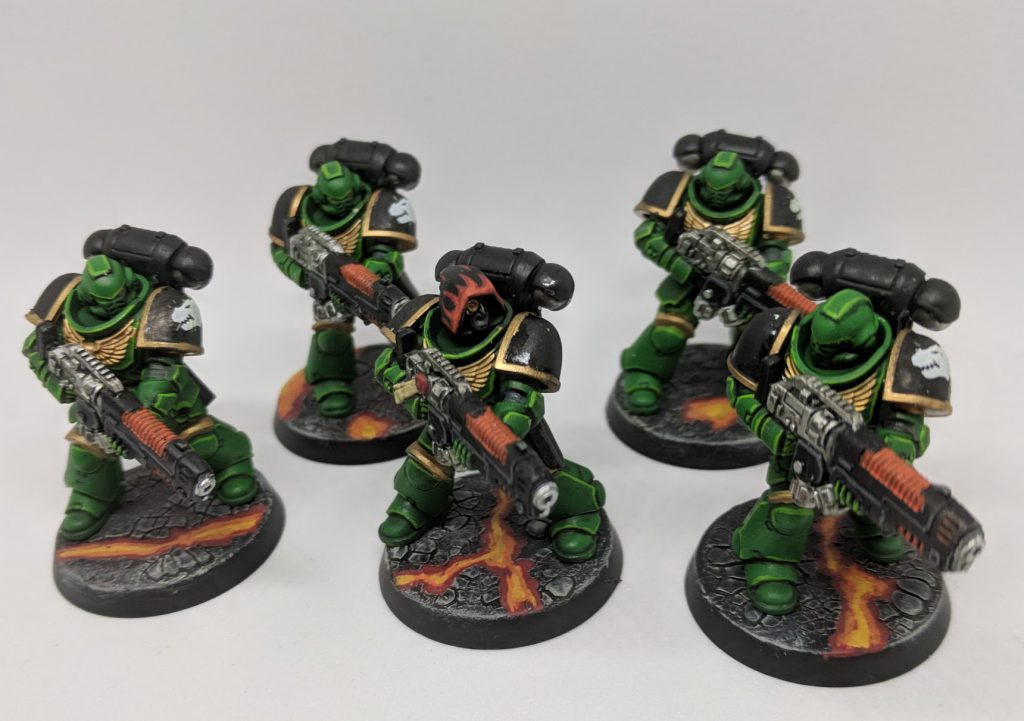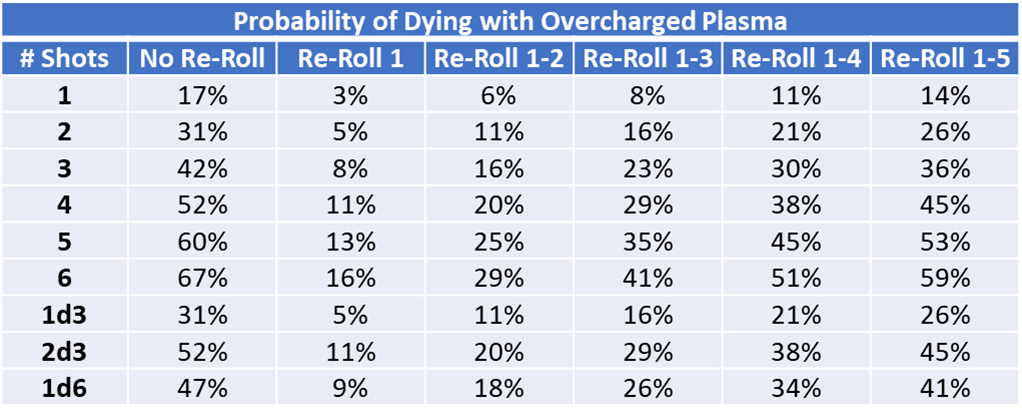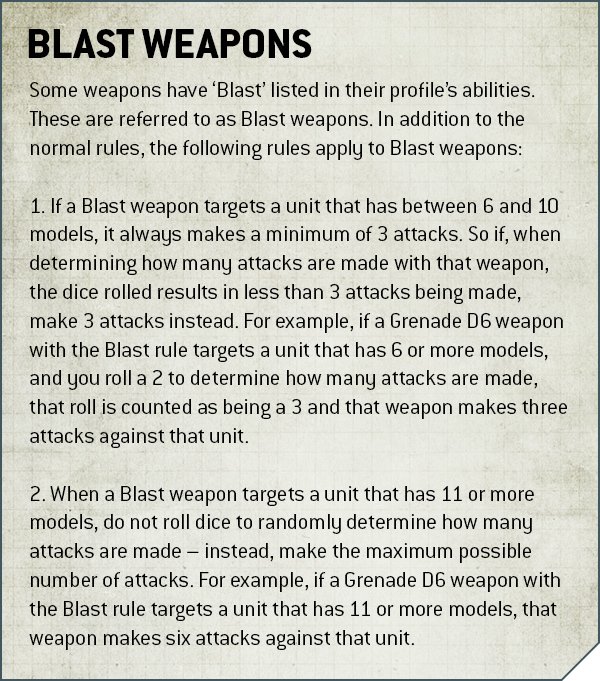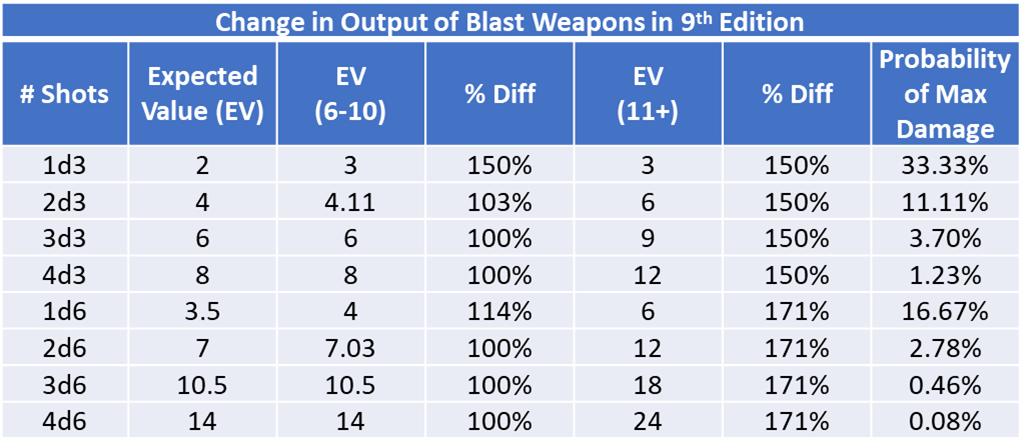While we don’t have the FAQs to get a complete picture of everything, we do know quite a few pieces of information about how different weapons will work in 9th Edition. This gives us an opportunity to look at the changes from 8th to 9th and see what’s significant… and what might not be.
The 9th Edition previews on Warhammer Community have given us a glimpse of quite a few Datasheets. We saw changes in the melta weapons from the Eradicator Datasheet, that plasma has changed via the Assault Intercessor Datasheet, and of course there’s the new Blast keyword which provides a significant floor to damage output depending on the size of the target unit. Some of these changes are subtle, some are significant, but all are worth knowing. As a caveat please note that we are only basing this information off of the Indomitus Datasheets provided by Warhammer Community and as a result if there is something different in the FAQ we have no way of knowing.

Plasma
In 8th Edition, overcharged plasma killed the bearer if the die roll result was a 1. This meant that the effect was depending on modifiers, which never made much sense but was a function of the rules for years. A +1 modifier made the bearer immune to the effect, while a -1 or -2 modifier doubled or tripled the probability of the firer immolating themselves in an incandescent plume of the God-Machine’s ire. 9th Edition sees the rule change in a very subtle but important way:
On an unmodified hit roll of 1, the bearer is destroyed after shooting with this weapon.
The probability of plasma destroying the model is now fixed at 17% regardless of the modifiers to the roll. There’s no way to escape it. The best you can hope for is to re-roll the result and limit the chances of it occurring, but for some models this is a death sentence. The chart below shows the probability of a model being destroyed based on the number of shots used. The probability for this is fairly simple to do; find the probability that none of the shots will result in a destroyed model and then subtract that from 1. Ultimately it doesn’t matter if the model rolls a single 1 or six; it’s still destroyed. Unfortunately this also means that overcharged attacks cannot be fast rolled; you have to do it model by model to ensure you know which one dies. This is particularly important given the significant damage that can be done in the Morale phase if a unit is out of coherency.

The results show several important things. First, it’s important to make sure that the benefit of overcharging plasma is truly worth the price being paid. Something like Inceptors firing plasma exterminators will get 6 shots each thanks to being blast weapons if the target unit is 6 models or more. If overcharged and with no re-roll that means 2 of the 3 models are likely to kill themselves and the remaining Inceptor will be taking a Leadership test and could disappear as well. Similarly if your unit is lined up in such a way that the death of a model will break coherency then not only will you lose the models that die from overcharging, but you’ll have no way of stopping more of the unit from disappearing in the Morale phase. Note that under the Astartes Banner rules for the Bladeguard Ancient in the Indomitus Datasheets there is another change; models only get to use the banner ability if they are destroyed from an enemy attack.

Melta
Melta weapons received a bit of a bad break in 8th Edition. From a mathematical perspective the number of shots and the amount of damage that a weapon deals have an equal impact on the expected output of a weapon. From a variance perspective this made high-shot weapons more preferable to the all-or-nothing outcome of a single shot, high damage weapon. This was alleviated somewhat by the melta rule; if the attack gets past the save and the distance is under half range then the attacking player rolled two damage dice and discarded the lower result. In 9th Edition the rule is oddly different:
When resolving an attack against a unit that is within half range, roll two D6 when inflicting damage with it and discard one of the results.
Mathematically the result is identical when looking at the upper bound; the expected value for 2d6 dropping the lowest is 4.47, a full damage point higher than rolling a single 1d6. If for some reason you would wish to pick the lower then the expected value is 2.53. In other words being able to discard any of the dice instead of the lowest gives you more flexibility to achieve a desired effect.
We’re just not entirely sure what that desired effect would be. The Goonhammer Brain Trust spent quite a bit of time thinking about this, and as far as we can tell one possible scenario is perhaps one where you want to injure a target but not necessarily kill them. The only other thought is that maybe this will interact with a damage-based rule like Quantum Shielding, for example by picking the lower damage result, but that’s something of a gamble. Either way this is a weird one.

Blast Weapons
8th Edition brought about a major change in the form of blast templates being completely eliminated. In every edition before that, certain weapons would use either a teardrop shaped template (for flamers) or a 3″ or 5″ disc. Every model located underneath the template was considered a hit. This meant that the placement of models directly determined the outcome, which slowed down the Movement phase considerably. In 8th this was completely eliminated in favor of a random number of shots. Weapons like the demolisher cannon, which could deal a S10 hit to anything under a 5″ template, were now getting a laughable 1d3 (1d6 against units of 10 or more) shots which still required a hit roll. GW later acknowledged that somewhat and FAQ’d the demolisher to 1d6 shots against all targets but it was still nowhere near what it used to be. 9th Edition has taken a step back and attempted to accommodate the effect of Blast weapons via a new special rule.

Rob does a great job of covering what this means in one of our 9th Edition Ruleshammer articles, but in mathematical terms the change dramatically mitigates the variability of blast weapons and makes them devastating against larger units. The extent of the variability depends on how the attacks are calculated. For example a Wyvern quad stormshard mortar (4d6 attacks) always deals a minimum of 4 attacks so it would see no difference until targeting a unit of 11 models or more, while a venom cannon (1d3 attacks) will max out its attacks against any unit of 6 or more models. This combination of a floor and ceiling has some… interesting consequences for the outcome as seen below.

The chart above shows how the output of a weapon will change depending on the number of dice rolls and the type of dice being rolled. The columns show the change in expected value (mean number of attacks) relative to the baseline, and the final column on the right is the probability that in 8th Edition a particular weapon would generate the maximum number of attacks. There are some significant takeaways here.
- For units of 6-10 models, the effect translates to roughly one half to one more attack for weapons with a single dice, and no significant difference for weapons that use multiple dice.
- Once you reach the 11th model, things become dramatically worse. The change in mean attacks increases by 150% or 171% regardless of the number of dice rolled.
- The change in mean attacks doesn’t tell the complete story due to how improbable it is for multiple attack dice to maximize their value; even weapons with 2d6 attacks rarely fire 12 times.
- On average a Wyvern quad stormshard mortar would have to fire 1296 times to deal maximum attacks once in 8th Edition; in 9th it can do so every time it targets a large unit.
Now it’s essential that we caveat that this analysis is based on incomplete information. Without access to the FAQs it’s impossible for us to know if the Wyvern quad stormshard mortar still gets 4d6 shots, or if there are special rules which change everything, or if there’s errata which alters the rule as we understand it. All we can do is work with the information provided.
1d6 Shots and Re-rolls
The last thing we’ll cover is the change in probability for using a re-roll for a 1d6 attack Blast weapon when facing a unit of 6-10 models. Assuming nothing changes in the FAQ this is an ability that many armies have such as Catachan Astra Militarum regiments. For a 1d6 roll without a floor the optimal strategy is to re-roll all values of 3 or less; this is because the expected value is 3.5 and as a result on average you will get a roll higher than 3. Of course there’s still a good chance that you will get a value of 1 or 2, and some players may not wish to take that chance. When re-rolling all d6 results of 3 or less then expected value for the d6 roll jumps from 3.5 to 4.25. On the other hand if only results of 1 or 2 are re-rolled then the expected value is 4.17. Whether or not that extra 8% is worth the risk is up to the player.
For situations where there’s a floor the probability is slightly less stressful. If the minimum possible value of a 1d6 roll is a 3, then the expected value of that roll is 4. This means that there is no difference between re-rolling all results below 3 or re-rolling all results below 4. The expected value is the same; 4.5.
Wrapping Up
This was a big article covering a pretty major topic, and I appreciate you taking the time to read it. Here are the major takeaways:
- It’s essential to remember that this analysis is based on incomplete information, as we don’t know what has changed in the FAQs.
- The consequence of a model always having a chance of dying from an overcharged plasma shot means that players need to be very careful of when the overcharge their weapons.
- This is particularly true because of the chance that a dying model will cause the unit to go out of coherency, resulting in even more models removed during the Morale phase.
- Allowing players to choose their damage die for melta weapons below half range is a curious choice; the extra flexibility is good but we’re not sure when you would use it.
- Blast weapons have a relatively minor impact on units of 6-10 models, but are absolutely devastating against units of 11 models or more.
- Against units of 11 or more models the change in expected value is the same for all numbers of d3 or d6 based attacks.
- The larger the number of d3 or d6 attacks being rolled, the more extreme the results against units of 11 or more models will seem to due how improbable it is to get a maximum result.
- In terms of re-rolling attacks of 1d6 with a floor of 3, it doesn’t change the expected value to re-roll all results or 3 or less or 4 or less.
.Thanks for reading! If you have any feedback, feel free to drop a note in the comments below or email us at contact@goonhammer.com. If you have any questions that you would like answered in a future article, please submit them here.


